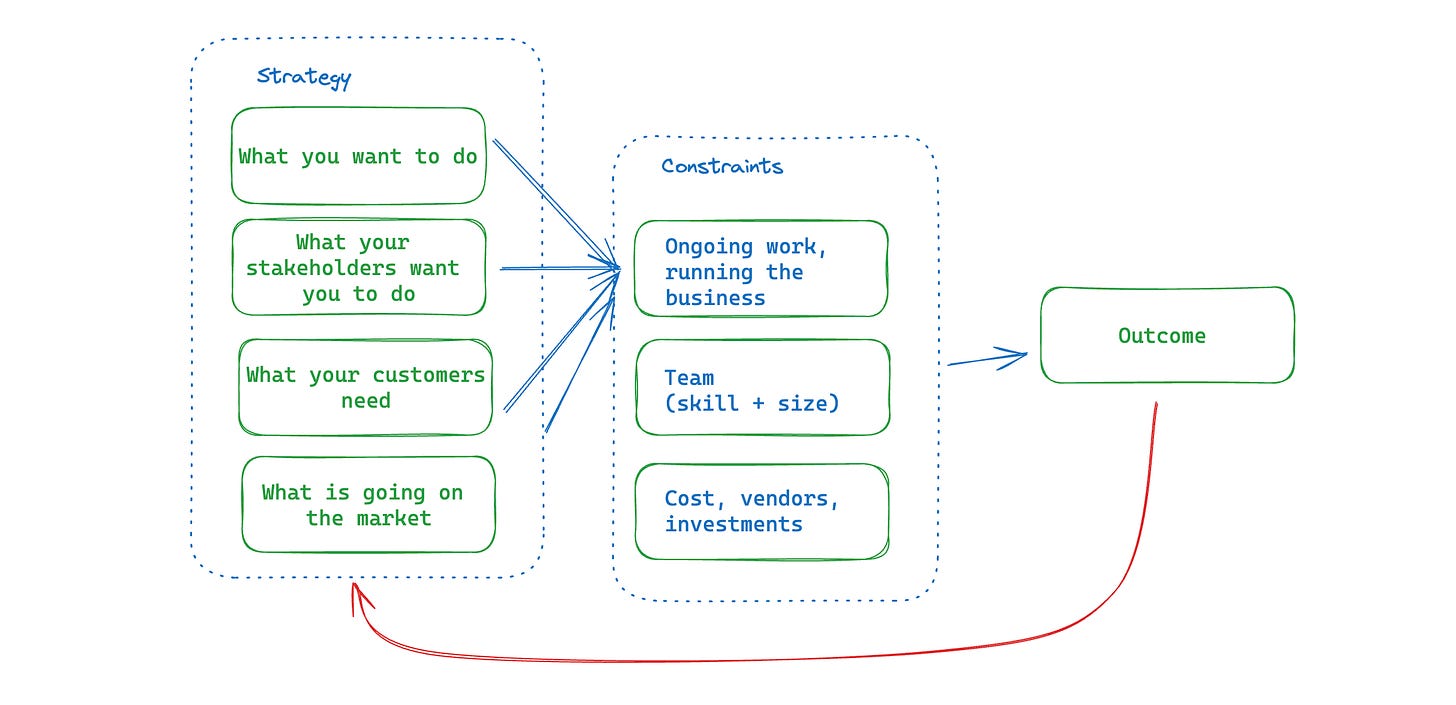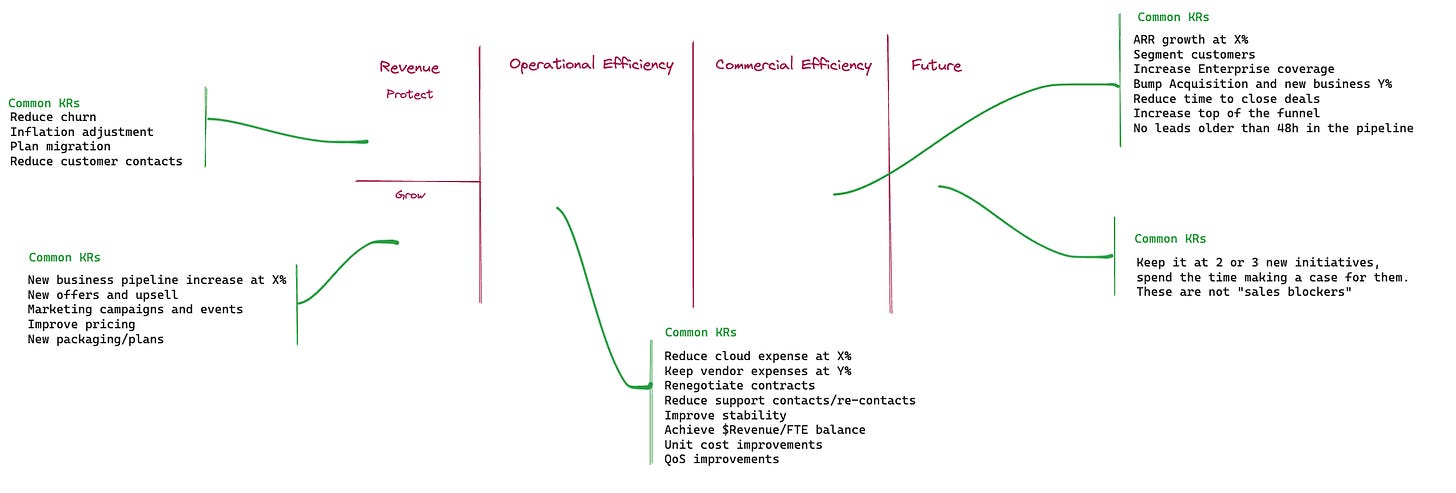Planning toolbox
Going from 0 to plan your budget
Scrambling to finalize a budget under pressure is a common (and painful) experience for tech leaders. Traditional finance frameworks often lump tech costs into broad categories (Vendor, Infosec, Payroll and Cloud), making it difficult to accurately represent your needs.
It is important that you, a tech and product leader, get involved in the planning process early on, either yearly or mid-year budget review. A reactive approach leads to rushed decisions and missed opportunities.
This guide is an opinionated toolbox that outlines a simple approach using familiar tools to get your planning and budget in line, and avoid scrambling to meet unrealistic expectations.
You will see that I use a fixed model to plan but I focus more on data and information you need beforehand. It seems a lot of work but once you tackle and adapt it, it becomes a progressive effort and you won't need to start from ground zero.
The machinery behind planning
Understanding how the wishlist funnel works
To turn strategy (what we think will move us closer to success) into outcome (product, feature, new verticals, sales increase, investment, IPO) we have to consider constraints (time, money, headcount, market).
Strategy is not always about building the new and the sexy app - it involves a bottom up and top down dance to try to cover the most ground that overlaps what your customer needs, what the market trends, what stakeholders want to commit to their goals and what you see fit to do.
How to identify constraints
Ongoing work, Run the Business, Keep the lights on: This is where wishes hit the budget. There is a limited amount of time and impact of hiring to grow a team. Assuming this is everyone's work and responsibility, start from there.
Hiring: After the last rounds of layoffs we saw that it was not scalable to double the teams to try to do everything everyone wants. Deciding what to do and what not to do is very important and affects directly how big your team will be. This should be done within the context of the decision makers.
Team skills: M&As, coding, new and old stacks, cloud, new business verticals, legacy platform, B2B to B2C moves - all nice and good but can your team do it now ? If not, when ? Or where to find who can do it and how long will it take ?
Cost management: Cloud economics are not for free. Internal applications too. Duplication, dependency on SaaS. Take care of third party dependencies on your profit path, as if they change conditions your baseline is directly impacted.
Planning canvas
A canvas is an useful tool to enable group discussions. In this canvas I've translated the constraints above as high level columns. Within these columns, you will place initiatives that belong to one or more of these columns. This is where most of the discussion should happen.
Do not get fooled by the appearance of agile boards, it is not. This is where you and your peers will get clarity without spending time learning OKRs or any other complex methodology. This should represent what is on everyone's mind.
You can use post-its or write directly, just remember to duplicate it if an initiative impacts operational efficiency and revenue, for example. This is a signal that this initiative has high potential of prioritization as it impacts more than one aspect.
Revenue: revenue sources and initiatives to protect and grow it
Operational Efficiency: cost, how we do things, optimizations, what we can leave behind
Commercial Efficiency: how we sell, how fast we bridge it
Future (business/revenue): what is the single bet that will generate new revenue or improve our valuation ?
OKRs, KPIs, Canvas users: There will be a lot of familiar items there. If something sounds like a task, it shouldn't be there. If it is just a single word, elaborate on it. If it is an OKR - forget about it. Your OKRs are the column titles :)
Common Key Results and items in the Canvas
Information and Requirements you need before planning
Gather the % of time of each team spent on, based on the Run the business/Grow the business framework:
Running the business - what you do to keep the lights on and retain existing customers
Incidents
Improvements and small fixes
Manual work required to keep the company running (scripts, API calls, back office work)
Growing the business - what you do to get new revenue and expand market share
New products
Features that allow new customer segments to use existing products
New business lines
Describe and measure important acquisition and retention flows
Onboarding friction
Customization and professional services that enable sales
Lack of organization is exposed as complexity for the client
Red paths (most used flows) that affect current revenue
Clarity on team journeys and headcount
Make sure your teams are named as what they do, do not expect others will infer names based on movies/internal jargon. E.g.: payments take care of order to cash and money, core maintains the core platform, and so on.
Shared headcount between journeys and initiatives as N2 support, QA, Product Designers, Data Analytics.
Headcount you have that support other teams outside of product and tech.
Always evaluate your management layers: context, reach outside of the team and last performance evaluations.
Fill up this template: Team staffing and journey templates
Budget and Market
Cloud and vendors expenses and potential increases
Simple 3 months forecast
Revenue per product/big feature
ARR (projected/needed)
Burn rate
SG&A expenses and headcount
Make each team's dream work on paper
Sales: bets with projected revenue
Product: Where do we go from here?? What’s new? (not AI please)
Everyone: “If I worked at a company that wanted to overtake our company business, I’d do X”
Marketing: growth and acquisition projected revenue
Appendix
Rules of engagement
Speak shortly, directly
Assume we have limited capacity, and should actively decide where to use it
There is work being done to keep what we have. Is it more important than what we (imagine) want?
No politics, no ego
Consider that the output of this planning may require a re-org at all levels
Tips for strategic discussions
Product: Gathering and discussing requirements is not as common as we think it is - even on small companies.
Marketing: Questions about Market usually leads to a lot of soul searching that can be hidden behind product deliveries at some point.
Sales: Avoid common places as “We will not sell if we don’t do X” or “We have to do AI”. These are financial goal setting questions, not strategic question. Look for marketing data to confirm or correct course. Communicate team growth and investment on tools that you need to operate as they usually demand integration.
Engineering: Look into time spent between addressing technical debt, migration and development. Training and onboarding.
If you are looking for tools and ways to get your team moving, specially if you are starting in a new role maybe you want to know that I wrote a book called The CTO Field Guide. It is a book to help engineering leaders of all levels. If you need help, check the mentoring program based on the book at https://ctofieldguide.com/mentoring.html.



